Calendulas of all types are a simple way to bring wildlife and colour into your garden. However, their vivid and varied colour palette, and mixed growth habits make them challenging to use in garden design as every Calendula species has varied heights, spreads, and flowering vigour.
But don’t worry, we’ve got you covered with this guide on how to grow, use, choose, and even eat calendulas, and hopefully we can steer you towards a successful season of flowering calendulas.
More...
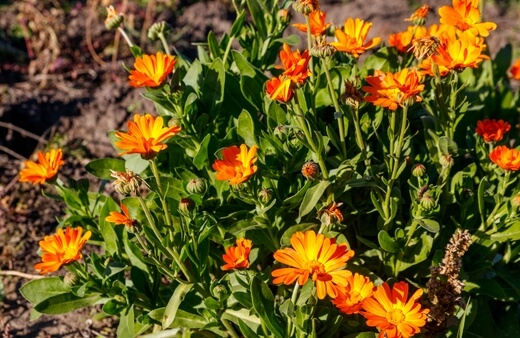
Family: | Asteraceae |
|---|---|
Genus: | Calendula |
Species: | various |
Common Names: | Calendula, Pot Marigold, Field Marigold |
Location: | Outdoors |
Type: | Herbaceous annual or perennial |
Growth: | 20-30 cm tall, 10-30 cm wide |
Sun requirements: | Full sun or part sun |
Foliage Colour: | Green |
Flower Colour: | Yellow, orange, red or white |
Flowering: | Year round |
Fruit: | None |
Maintenance level: | Low |
Poisonous for pets: | Non-toxic to cats and dogs |
What are Calendulas?
Calendula are commonly called marigolds, but they are two separate genera. The accepted name of marigold only truly refers to the Tagetes genus, and it’s quite easy to identify between Calendula and Tagetes when you know how.
Tagetes (true Marigolds) are typically low growing, though some can grow to about 30-40 cm as annuals. They nearly all have deeply serrated leaves and fairly tufted flowers, with a strong lemony fragrance when you rub their leaves.
Here is our comprehensive guide growing and care guide for Tagetes (Marigold).
Calendula are more varied in height, but have long, smooth, un-serrated leaves. Their flowers can be lightly tufted, but are typically more daisy-shaped. Both genera are in the Asteraceae family, which includes daisies, asters, sunflowers, dahlias, chrysanthemums, fleabane, echinacea, and even some trees.

Natural Habitat of Calendulas
The Calendula genus is widely spread across the Mediterranean and Western Europe, Southwestern Asia, North Africa and Macaronesia. There are several species that are only found wild in highly exposed coastal areas, while others grow inland as meadow flowers, or on open grassland.
Perhaps the only shared condition of calendulas is that they all prefer full sun in nature, but will grow best with afternoon shade through most of Australia.
Different Types of Calendulas
While calendulas and marigolds are strictly separate genera, their visual similarities have led to most of the popular garden varieties having Marigold as part of their common names.
Rather than focussing on the hundreds of cultivars you can grow, getting to grips with the species' characteristics will give you a better idea of the different types of calendulas you can grow, and their habits when grown throughout Australia.
Calendula Species
The list below does not include a few commonly referred species as they are in fact synonyms for the species and subspecies listed below. For example, Calendula maritima is in fact a subspecies of Calendula suffruticosa.
Calendula arvensis
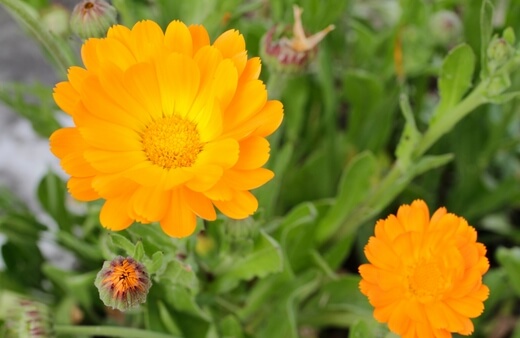
The field marigold, C. arvensis, has long leaves with slight ridging along their borders, and when well kept, will develop a fine coating of hairs across the leaf. Its flowers are simple yellow daisy forms, and they can grow to about 40 cm tall to create frothy yellow backdrops to borders.
Calendula eckerleinii
Perhaps the most delicate of all calendulas is the African daisy, or C. eckerleinii. It is known to come in about seven different forms, but always has long stems with single flowers at their tip.
To deadhead these frothy daisies, cut each flowering stem back to the base.


Get Your Free Guide:
Master Growing Australian Natives eBook
A Must Have Complete Guide for Every Australian Garden
Get Your Free Guide:
Master Growing Australian Natives eBook
A Must Have Complete Guide for Every Australian Garden
Calendula lanzae
C. lanzae are native to Morocco, and really quite easy to grow in Australia, but do need good irrigation. Their long stems and sun-burst orange flowers are highly illustrative and look gorgeous on salads.
Calendula maroccana
C. maroccana (including the two subspecies C. maroccana subsp. maroccana & C. maroccana subsp. murbeckii) are leggy drooping calendulas that only truly work in coastal gardens of shale or rocky soil.
They require exceptional drainage, humid winds, and very regular deadheading, and spread into clumps of plants about 1m across.
Calendula meuselii
One of the easiest Calendula species to grow in Australia is C. meuselii, which self-seeds easily, and germinates in most conditions in spring. It will definitely need to be planted in partial shade, and with excellent drainage.
Calendula officinalis
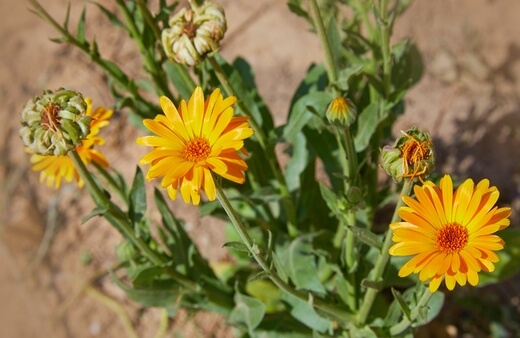
The best known Calendula, and the easiest to harvest and use in salads or medicine, is C. officinalis, or the pot marigold. Its multi-layered flowers come in all sorts of colours.
Pot Marigold is the most highly hybridised species of Calendula out there, with forms that reach just 5cm tall, and other reaching 30cm tall with dense, grassy-green foliage and flowers in every shade of white, yellow, orange and red.
Calendula palaestina
Native to the Mediterranean and Western Asia these calendulas are very fast spreading, and will self-seed all over the garden. If you are trying to develop a wild patch of garden, they may be useful, but in most cultivated settings, they are too hard to control and should be avoided.
Calendula stellata
Also called Calendula denticulate, these compact calendulas are often found in rockeries and dry gardens as they are well adapted to dry conditions. They will grow in most sandy Australian soils, and with a bit of feeding, which flower all year round.
Calendula suffruticosa
There are at least eight accepted subspecies of C. suffruticosa, one of the lowest growing Calendula species there is (typically 5-10 cm, depending on the subspecies). They grow well in rocks and gravel, and require little to no actual soil to germinate.
Calendula tripterocarpa
Another useful calendula for gravel gardens is C. tripterocarpa. Its upright flower stems will rise above competing grasses, and its foliage is low to the ground, preventing the development of other weeds around it.
Its sparsely placed spiked petals add a little bit of uncommon interest which sets them apart from other species.
Uses and Benefits of Calendula Flowers
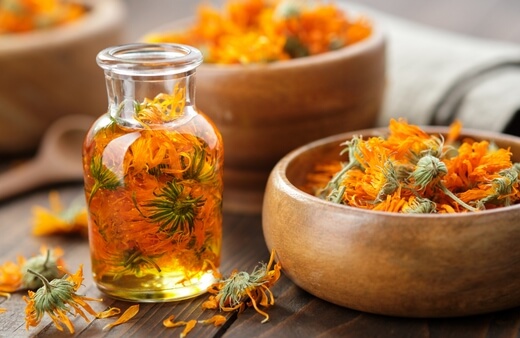
Calendula oils, extracted from dried flowers, have antifungal, anti-inflammatory, antioxidant, and antimicrobial properties. All of this combined makes a powerful and effective treatment for burns, buts, skin rashes and ongoing dermatitis.
Aside from their medicinal uses, their flowers can be eaten raw and add a flavour similar to young rocket (slightly bitter, with gentle peppery heat). Their leaves can be harvested and used as a replacement for radicchio, and have a slightly more rounded, but still sharp flavour.
Note: While there have been trials in pregnant women and breastfeeding mothers, there isn’t enough evidence of safety, so it should be avoided as a topical or ingested treatment while pregnant or breastfeeding.
Uses of Calendula as a Companion Plant
As well as being a useful edible flower, it is a handy companion plant in the vegetable garden, as they help to attract both pollinators and predatory insects, which prey on pest species like aphids and whitefly.
Calendulas work particularly well as companion plants for tomatoes, carrots and asparagus, as they deter root pests and grubs in the soil.
Note: True marigolds (Tagetes) are better companion plants for most vegetables as they actively deter pests as well as attract predators, but they are mostly annual plants so need sowing each year. Perennial Calendula species are a low-maintenance alternative to Tagetes.
How to Grow Calendulas in Australia
Calendulas are simple to grow, from seed, cuttings, or seedlings. They need plenty of natural light, and reasonable, but not heavy irrigation. In most Australian gardens, they will come back year after year and can self-seed around your borders without being overly invasive.
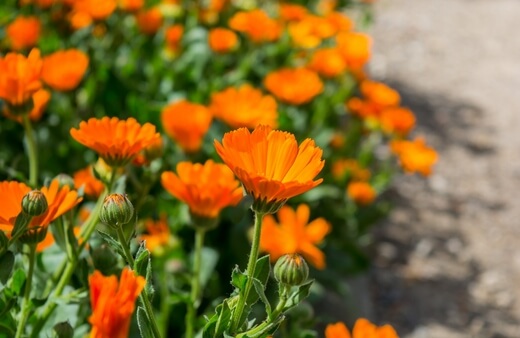
How to Propagate Calendulas
Growing your own from scratch is easy and fun, and their high germination rates make them a great way to get kids into gardening (because no one’s first experience in the garden should be a failure).
Follow the step-by-step instructions below to guarantee successful calendulas this spring.
Propagating Calendulas from Seeds
Calendula seeds can last in storage for about ten years. Most online advice suggests three to four years, but we planted three old packets of calendula seed from 2014 last year, and they all germinated.
There is no need to pre-soak the seed, and you can even adapt these sowing instructions depending on whether you are sowing indoors or directly in the ground.
- Start by preparing your soil.
- For indoor sowing in autumn or winter (or sowing in cold frames and greenhouses), fill small pots with loose, free-draining compost.
- For outdoor sowing in spring or summer, clear the area you are planting into of weeds, and dig over the top 5-10 cm of soil. Rake it to an even loose consistency.
- Water the soil lightly before sowing.
- Sow thinly (a small handful of seeds will cover 1m2).
- Cover them with a light layer of sieved compost to provide nutrients and hide the seed from birds (they look a lot like caterpillars, so will be eaten if they are visible).
- Water over the top every other day until they germinate (2-3 weeks depending on the time of year).
- Pinch out the tips of seedlings above their first true leaves to encourage bushier growth.
- Plant out potted seedlings when their roots fill the pots.
Propagating Calendulas from Cuttings
After flowering has finished for the year (late autumn or early winter), take a basal cutting of any perennial calendula (it can work with annuals, but they will need to be stored away from frost, and allowed to grow and flower through winter).
Basal cuttings are simple to take, and essentially involve a section of stem, cut just below the soil. Ideally, the cutting will include a small ‘tail’ of the root. Dip your cutting into rooting hormone to encourage new roots, and store them somewhere warm and bright but away from any direct sunlight.
After a few weeks, you’ll have new calendulas ready to plant out, which will flower in the same year.
Best Conditions for Planting Calendula

If you’ve bought seedlings, or sown your own, planting calendulas is simple. They’re not shrubs, and they have light roots, which are able to make the most of the space they are given, just plant quite simply in any garden soil, with compost mixed through.
If you’ve got heavily compacted soil, dig a hole that’s a little bigger than its starter pot.
Best Soil to Use
Calendulas love compost, and will grow quite happily in a pot filled with pure garden compost. But, for better results, and to reduce the chance of mildew, add perlite or vermiculite to your container.
For calendulas planted in the ground, mix fresh compost or very-well-rotted manure (fully broken down, with a loamy soil consistency) into the surrounding soil.
Finding the Right Light for Calendulas
Calendulas naturally prefer full sun, but they grow in much cooler climates. Most Australian gardens will have a spot with some shade from the full heat of the afternoon sun, which will be perfect for calendulas. If you do grow them in full sun, make sure to water them regularly.
Caring for Calendula

Watering Schedule
Aim to water your calendulas two to three times a week in summer (once is enough in cooler parts of the country). Essentially, if the surface of the soil looks dry, they need watering.
If you’ve been away for a week, don’t worry, they react quickly to watering, and can go from droopy, sad looking plants, to rigid and upright flowers in a couple of hours after watering.
Feeding Calendulas
Calendulas don’t need much in the way of fertiliser, provided they have enough compost in the soil. If your calendulas are growing leggy, or developing normally, but with pale foliage, it can be worth adding nutrients with a simple tomato fertiliser or liquid seaweed once a week. You should see results about a week after the first application.
Deadheading Calendulas
Calendulas are workhorses. They simply won’t stop flowering until frost hits them in most parts of Australia, but it will take a little bit of work on your part. The instinct of any flowering plant is to set seed quickly and efficiently, to give seeds time to germinate and die back in their first year, or to expose them to winter cools.
If you allow flowers to go to seed, the flower will exhaust its energy on that, rather than flowering, so deadhead regularly, as soon as the flowers begin to fade.
Possible Calendula Pests and Diseases
It is very rare to have any significant pest problems with calendulas as they are very effective at attracting pollinators and predatory insects into the garden, including bees, wasps, and ladybirds. If you do find aphids on your calendula plants, spray them off with a hose to reduce their numbers.
Like all plants, calendula can suffer from root rot if it is significantly over-watered, but the most common problem is mildew. Powdery mildew can cause a fine white haze over the leaves of your calendula, and will either require the leaves to be removed and burned or treated with a copper fungicide.
To prevent mildew on calendulas before it happens, make sure they are well-drained, and reduce watering drastically in early autumn as the nighttime temperature starts to drop.
Mildew is typically caused by humidity or damp environments, and requires wet leaves to take hold, so do not water the foliage of your calendulas at any point during the year. Instead, target water right at the base of the plant to keep the foliage dry.
Calendula Frequently Asked Questions

Do calendulas come back every year?
Most calendulas will come back in the garden every single year. While the Calendula genus is a mix of annuals and perennials, they will self-seed anywhere that they grow, so even annual calendulas will return as new plants each year, regardless of whether the original plant has died.
What is calendula used for?
Calendula is most commonly used as a medicinal flower, either in tinctures or ointments, as a treatment for cuts, bruises, and minor fungal infections.
How do you prepare calendula flowers for medicinal use?
Preparing calendula tinctures for medicinal use is actually pretty simple. You’ll need to dry your flowers in the sun for a few days (sometimes up to a week, until they are crisp), and then add them to a bottle of vodka.
After a month, strain the vodka through muslin to remove the remains of the petals and the coloured liquid is a basic tincture. You can add that to creams, or use it directly on cuts.
How do you prepare calendulas for edible use?
Harvest calendula flowers when they are in full bloom, ideally in the morning. Cut just below the flower, or pinch them off, and remove the green shoots (they are safe to eat, but unpleasant).
Then leave the flowers submerged in a bowl of water to remove any insects. That’s it! Ready to eat calendula flowers.
What pests does calendula repel?
Calendula repels tomato hornworm, asparagus beetles, root knot nematodes (also beneficial nematodes), and carrot fly larvae.
What are the risks of calendula?
You should not use calendula if you are pregnant or breastfeeding. Other risks of calendula extracts can include drowsiness and slowed breathing so it should be avoided if you have existing sleep apnoea or take sedatives to support mood disorders
Is calendula good for wound healing?
Calendula officinalis is the most common species used in herbal remedies and is good for healing wounds, in that it reduces inflammation and prevents infection.
Does calendula attract slugs?
Calendula is commonly eaten by slugs and snails but does not specifically attract them to your garden. They are a tasty alternative to dandelions and salads for slugs, so can be quite a useful distraction plant around the edge of veggie beds.
Is calendula invasive?
Calendula self-seeds in most environments but is not invasive. It cannot outcompete Australian native species and is easy to manage and control when it does self-seed.
Does calendula attract bees?
Calendula is incredibly attractive to bees. Its bright and open flowers are ideal for bees and other pollinators, including hoverflies and wasps, which will also help to reduce aphid populations in your garden.
Wrapping Up Our Calendula Growing and Care Guide
While I’m perhaps a little bit old school in my love of the simple Calendula officinalis (the pot marigold), there is so much choice in this useful genus of flowering plants that sometimes choosing the tried and tested types is the best option for most gardeners.
But, if you prefer to grow tall calendulas that rock in the wind, and help to add height to your garden borders, or if you prefer to grow lower maintenance perennial calendulas, you’ll still be able to use them in all of the same ways.
Published on February 17, 2023 by Maisie Blevins
Last Updated on February 23, 2024




